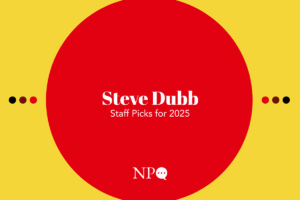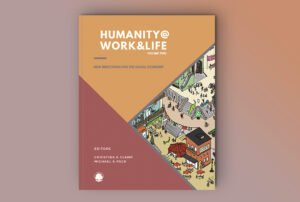
Editors’ note: This piece is from Nonprofit Quarterly Magazine’s summer 2024 issue, “Escaping Corporate Capture.”
The billionaire owners of the Kansas City Chiefs and Kansas City Royals ran an election campaign this spring, seeking more than $6.4 billion for stadium upgrades and a low-cost lease that would last until 2071.1
In exchange, the teams touted their “community benefits agreement” offer of $266 million, a measly 4 percent of what they’d get in subsidies from area residents.2 But the so-called CBA was fake: no community groups were signatories to it.3 The Missouri Workers Center, the Heartland Center for Jobs and Freedom, and MORE2—among other groups—all left the negotiating table because the billionaires refused to help with affordable housing and guaranteeing that stadium workers earn a living wage.4
Only the teams and the city agreed to this “historic” deal. And within the CBA was a laundry list of the owners’ philanthropy—making it clear that they see the deal as charity, not justice.5
Never far from the surface was the implied threat—it often does not even need to be uttered—that the sports teams might move elsewhere if they didn’t get their way, as recently occurred when the Oakland Raiders became the Las Vegas Raiders.6
If the Kansas City story sounds all too familiar, welcome to the land of economic development subsidies. It’s trickle-down economics on steroids—in which some of the biggest corporations (usually led by White men) extract huge sums of public money for corporate and personal profit.
[T]he federal government has largely left each state on its own to compete against other states for jobs and tax revenues. The result has been an imbalance of power.
Business basics, not subsidies, are what almost always drive such site-location decisions. Companies may throw a bone to communities, but it’s nowhere near the money they take and not enough to enable taxpayers to ever break even. And when costs and benefits are crunched by race, income, and geography, such deals worsen racialized inequality.
In short, what passes for “economic development” is too often little more than politician-abetted corporate extraction of public resources.
Why “Incentives” Are Usually Corporate Windfalls
Economic development incentives, as their name suggests, are supposed to be used to make something good happen that isn’t happening—and that wouldn’t happen without public dollars that reduce private investment risk: individuals and companies want significant returns on their investments. Think neighborhoods long redlined, industrial areas left contaminated, historically disadvantaged groups of workers, and so forth.
But that textbook definition became roadkill long ago, thanks to the corporate capture of the jobs debate.
Outside of military procurement, and until the very recent Biden administration efforts to support microchip production and carbon reduction, the federal government has done little to implement “industrial policy” to set common standards for business nationally.7 Instead, the federal government has largely left each state on its own to compete against other states for jobs and tax revenues. The result has been an imbalance of power. Corporations have benefited—using rigged, secret auctions designed to make state and local governments bid against each other and overspend for jobs. All told, states and localities spend an estimated $95 billion per year on company-specific awards—mostly in foregone tax revenue. In 2022, eight individual factory packages averaged $2 billion each.8
This process began in the Great Depression, expanded in the postwar period, and has only gotten more severe over time. Famously, Business Week dubbed the resulting competition the “Second War between the States”—48 years ago!9
Even today, as five federal bills pump several trillion dollars into the economy,10 Uncle Sam makes little effort to rationalize the distribution of funding—allowing companies, both domestic and foreign, to locate far from poor communities and in right-to-work states, where public officials brand themselves with wage suppression.11
“South Carolina’s low unionization rate, competitive labor costs and rapid population growth create a strong and dependable workforce,” South Carolina’s Commerce Department brags.12 When Volkswagen factory workers first tried to unionize in Chattanooga, TN, the governor, speaker, and former mayor joined anti-union groups in an all-out Vote No campaign.13 Ten years later, the workers voted two to one to join the United Auto Workers.14
Filling this federal policy void, footloose companies and the many transactors who profit from capital mobility have eagerly built a tax-break–industrial complex. Central to its power is the constantly reinforced dogma that tax breaks create jobs. Not markets, not innovation—tax breaks.
The real reasons a company chooses a place are never revealed. Cities and states are still “whipsawed” against each other in secret auctions to maximize subsidies.
Politicians seeking reelection are just as eager to play the game: Georgia Governor Brian Kemp and Michigan Governor Gretchen Whitmer awarded three of the biggest auto-factory subsidy packages in US history during their first terms in office, and went on to win second terms.15 Appearing to be active on jobs is a proven winner at election time.16
As the Center of Economic Accountability’s John Mozena likes to say, economic development subsidies “don’t really exist to create jobs. Instead, they exist to make voters believe that politicians are responsible for creating jobs.”17
But just how exactly did this powerful bipartisan dogma come to be?
Site-Selection Consultants: An Origin Story18
In 1934, a disgruntled industrial real estate salesman named Leonard Yaseen left Chicago for New York. He’d grown impatient with his father-in-law and boss, Felix Fantus. The old man wasn’t just helping corporate clients buy and sell real estate—he was also giving companies that sought to relocate factories information not just about land and buildings but also about transportation and utilities, local wages, and taxes.
Fantus was giving this valuable information away for free, but Yaseen thought they should be charging. Unable to convince Fantus to commodify his insights into a business, Yaseen left and founded the Fantus Factory Locating Service.
For the next four decades, Fantus dominated the site-location consulting industry, helping companies relocate thousands of workplaces—mostly factories moving out of the Northeast and Midwest to the far less unionized South.19 By its own count, it helped engineer more than 4,000 relocations by the time Yaseen retired in 1977, and 2,000 more in the next decade. Starting in the 1950s, the firm also helped companies hunting for sites in at least a dozen foreign countries. Over time, other players entered the field; today, there are more than 500 active US site-location consulting firms.20
Despite that fragmentation, the industry still deploys the information-control system Fantus invented. The identity of corporate clients is still held confidential until late in the process. The real reasons a company chooses a place are never revealed. Cities and states are still “whipsawed” against each other in secret auctions to maximize subsidies. That is, officials are told about competing incentive offers, and what they are told may or may not be truthful; and officials have no way of verifying anything they are told, because the Fantus-created system strictly prohibits public officials from communicating with their peers in competing locations—if they even know competing sites, which they usually don’t—lest they be blacklisted by site consultants next time for trying to break out of the prisoner’s dilemma.
Many site locators work on commission, taking 30 percent or so of the discretionary incentives they negotiate.21 Many have both private- and public-sector clients, claiming no conflict of interest. The elite service Site Selectors Guild hosts getaways for public officials, so that governments pay for face time with these investment-decision gatekeepers.22
It’s not just the Fantus process that lives on—its philosophy does, too. Fantus shaped the nation’s economic geography and our belief system about what constitutes a good “business climate.” The net result of those relocations was anti-union, anti–Rust Belt, anti-city, and anti-corporate tax.
Publicly reinforcing this secret auction system are decades of “politicized grab-bags of data” known as “business-climate reports.”23 Long issued by the accounting firm Grant Thornton for the Conference of State Manufacturers Associations, they live today in publications such as the American Legislative Exchange Council’s Rich States, Poor States report and the Tax Foundation’s State Business Tax Climate Index.24
Sign up for our free newsletters
Subscribe to NPQ's newsletters to have our top stories delivered directly to your inbox.
By signing up, you agree to our privacy policy and terms of use, and to receive messages from NPQ and our partners.
The Real Math and What Really Matters
What the site locators and business-climate barkers don’t discuss openly is the decision-making math. For the typical company in the United States, all state and local taxes combined come to just 1.9 percent of their overall cost structure. The business basics—labor, occupancy, raw materials, logistics, energy, IT, and other inputs—make up 98.1 percent.25
So, tiny variations in those big-cost items dwarf anything a tax break can do. That’s why business basics—not subsidies—almost always drive location decisions.
Of course, costs are only part of the equation. Benefits—what a company gets in exchange for its costs—are more important. Head and shoulders atop that list today is the supply of skilled labor, and as the Baby Boom generation finishes retiring, it will remain the number-one site-location advantage—that means good schools from which a company can recruit and into which it can transfer managers’ families.
Promisingly, there have been great strides when it comes to more equitable development. Transparency is foundational and especially critical to counteract the corporate secrecy that hides the tax-break dogma.
Amazon has proven the business basics argument twice over. In its rare public auction for a second headquarters, it ended up choosing the smallest of the subsidy bids by far from its 20 “finalist” cities: Arlington, VA. And after pulling out of Queens, NY, due to community protests, Amazon continued to expand in New York City anyway, growing its footprint and payroll in Manhattan.26
Long before that, Amazon had cut its subsidy-grubbing teeth on warehouses. As its business model evolved from sales tax avoidance to rapid delivery, it realized it could tout itself as a “job creator.” (Of course, those hundreds of warehouses drove many other retailers into bankruptcy.) In 2012, Amazon hired a site locator and birthed its “economic development” office.27
Since then, the company has been awarded more than $6.6 billion in state and local subsidies. Most of the deals are for warehouses, plus data centers and office complexes.28 The warehouse deals, as revealed in an interactive map, are invariably located near highways close to affluent zip codes where the most Prime subscribers reside.29
Fighting for New Models of Economic Development
Promisingly, there have been great strides when it comes to more equitable development. Transparency is foundational and especially critical to counteract the corporate secrecy that hides the tax-break dogma. Only with clear disclosure of subsidy awards and deal outcomes can anyone judge whether a company delivers.
By 2010, Good Jobs First found that 37 states had some type of company-specific, deal-specific disclosure. We launched a Subsidy Tracker to aggregate what had been a data Tower of Babel. By our 2022 report,30 48 states (plus the District of Columbia) were disclosing—all but Georgia and Alabama posted at least some information online. That list is now up to 49, after Alabama passed the Transparency in Incentives Act in 2023 to disclose the names of companies that had received economic development subsidies.31
Disclosure empowered the most significant state reform campaign, by the faith-based Together Louisiana. Stumbling upon eye-popping data a decade ago, the organization’s leaders began investigating how one unelected state board controlled local tax abatements that impoverished school districts, parish councils, sheriffs’ juries, and library districts. Working with then-Governor John Bel Edwards, the Louisiana activists won a set of reforms that by 2021 were returning over $280 million to public services every year.32
Those reforms added a requirement that the companies actually create new jobs, and also required affected local governments—not just a single unelected state board—to approve each deal.
Cities and counties nationwide have lagged behind the states in disclosure, but a wonky accounting rule is rapidly changing that. While Good Jobs First surveys found that only a third of big cities and counties were disclosing specific deals online, an obscure body that writes the rules for how governments keep their books finally woke up to tax breaks’ ruinous impact on some public budgets.
The Governmental Accounting Standards Board issues rules known as Generally Accepted Accounting Principles for the public sector. Updates to GAAP are known as “Statements.” In 2015, after hundreds of organizations and experts commented in favor,33 GASB issued Statement No. 77 on Tax Abatement Disclosures.34
Statement No. 77 requires most local governments—cities, counties, independent school districts, and so on—to add a note to their annual audited spending report on how much revenue they lost to any tax abatement programs. Even if the loss is passive—such as school districts losing huge sums to abatements that are awarded only by a city—the losing body must disclose the loss.
Taking effect in most places in 2017, Statement No. 77 has now generated six or seven years of data. So we can look for trends and mash up the data with variables such as race, income, and student demographics.
Of course, disclosure does not make a subsidy justified, fair, or effective. That takes organizing.
A small cottage industry of activists, academics, planners, and public agencies has begun using the abatement disclosure data, and the results are damning. While it has long been an axiom in economic development that “the poor pay more,” now we can measure that inequality precisely.
In the two largest school districts in the Greater St. Louis metro area, the majority students of color and 100 percent free-and-reduced-price meal students of St. Louis Public Schools lose 91 times more money to abatements each year than the 75 percent White, 9 percent free-and-reduced-price-meal children in the Rockwood School District/Rockwood R-Vi.35
On the opposite side of Missouri, the Kansas City School Board seized upon the Statement No. 77 data by 2020 and mounted a campaign—which is still ongoing—demanding that the city council reduce the size and duration of tax abatements. Losing a staggering $1,925 per student per year—mainly to development projects on the White side of the city—the then-school superintendent denounced abatements as “systemic racism.”36
Organizing for Community Benefits
Of course, disclosure does not make a subsidy justified, fair, or effective. That takes organizing. Alongside gains in transparency is the major new coalition model, community benefits agreements. Pioneered by the Los Angeles Alliance for a New Economy in the early 2000s, CBAs are a historic evolution of community and labor organizing.
These agreements are comprehensive rather than one-offs. Tailored to the impact of each project and the needs of the affected community, they may include local hiring preferences for both construction and permanent jobs, living wages, affordable housing, environmental and open-space provisions, and space set-asides for local merchants or social services such as day care or a health clinic.37
Popularized by the network now named PowerSwitch Action, the framework is increasingly common, and not just for use in single development projects—even some midsize cities such as St. Louis and Cleveland have enacted community benefits ordinances/agreements that apply to many new projects.
The community benefits frame is also woven deeply into recent federal legislation, such as the CHIPS and Science Act, the Inflation Reduction Act, and the Infrastructure Investment and Jobs Act.38
Democracy Is the Antidote
The tax-break–industrial complex being challenged by these disclosure and community benefits victories is, at its core, profoundly antidemocratic. By denying people access to the information and rights they need to shape their economic future, the corporate-dominated jobs narrative has contributed greatly to the nation’s rising racialized inequality—indeed, the biggest all-time deals have gone to companies led by White men.39
So while transparency and organizing are essential, governance also matters. Some states relegate tax abatements to unelected agencies, such as New York State’s industrial development agencies, which derive 80 percent of their operating budgets from tax abatement transaction fees—a perverse incentive to do needless deals and bigger deals.40 In other states, localities use public dollars to pay chambers of commerce to recruit new businesses, creating a system outside the reach of freedom of information or ethics laws.
Occasionally, voters get to weigh in. Back in Kansas City, where our story began, public outrage over a 40-year sales tax extension to subsidize two sports stadiums forced the Jackson County Legislature to put the proposed tax subsidy on the ballot. As we go to press, voters there dealt a “blowout loss” to the billionaires, defeating the tax by 58 percent to 42 percent.41
Notes
- Mike Hendricks, “Secret memo reveals ‘staggering’ cost of new Royals stadium for Jackson County taxpayers,” Kansas City Star, March 25, 2024, kansascity.com/news/politics-government/article281055678.html.
- Savannah Hawley-Bates, “Kansas City Chiefs and Royals say stadium deals will help the community. Economists disagree,” KCUR 3/NPR in Kansas City, March 25, 2024, www.kcur.org/sports/2024-03-25/ kansas-city-chiefs-and-royals-say-stadium-deals-will-help-the-community-economists-disagree.
- Ibid.
- Ibid.
- “Kansas City Chiefs, Kansas City Royals Announce Terms of Historic Community Benefits Agreements Worth $260M+,” March 20, 2024, Kansas City Chiefs, chiefs.com/news/kansas-city-chiefs-kansas-city-royals-announce-terms-of-historic-community-benefits-agreements-worth-260m.
- Tashan Reed, “How the Raiders’ move to Las Vegas has dramatically shifted their financial outlook,” The Athletic, October 13, 2023, theathletic.com/4794894/2023/10/13/las-vegas-raiders-business-finances/.
- For more information on industrial policy, see the Roosevelt Institute, “The American Industrial Policy Series,” accessed April 26, 2024, org/think-tank/climate-and-economic-transformation/the-american-industrial-policy-series/.
- Kasia Tarczynska, “2022: A Mega-Year for Megadeals!,” Good Jobs First, December 19, 2022, goodjobsfirst.org/2022-a-mega-year-for-megadeals/; and Arlene Martínez, “How Economic Development Subsidies Transfer Public Wealth to White Men,” Good Jobs First, June 12, 2023, goodjobsfirst.org/how-economic-development-subsidies-transfer-public-wealth-to-white-men/.
- “The Second War Between the States,” Business Week, May 17, 1976, 92–114. See also Greg LeRoy, with Philip Mattera and Kasia Tarczynska, Ending the Economic War among the States: A Strategic Proposal (Washington, DC: Good Jobs First, 2019).
- The five bills are the CARES (Coronavirus Aid, Relief, and Economic Security) Act, the American Rescue Plan Act (ARPA), the Infrastructure Investment and Jobs Act, the CHIPS (Creating Helpful Incentives to Produce Semiconductors) and Science Act, and the Inflation Reduction Act. Even with pandemic emergency spending, their economic impact persists. For example, the CARES Act, passed in March 2020, was used to suspend student loan payments until September 2023 (see Laura Rodini, “What is the CARES Act? Is it still in effect?” The Street, September 14, 2023, thestreet.com/dictionary/what-is-cares-act-is-it-still-in-effect). Funds from ARPA are still being spent in 2024 (see “Accessing Remaining COVID Relief Funds Before It Is Too Late,” National Council of Nonprofits, webinar, YouTube video, 1:00:31, January 31, 2024, www.youtube.com/watch?v=B3WkcglQVnI). The other three bills involve multiple years of ongoing expenditures and tax credits. On IRA and the infrastructure bill, see Steve Dubb, “The Social Contract: What’s Missing in the ‘Historic’ Biden Legislation?,” NPQ, November 29, 2022, nonprofitquarterly.org/the-social-contract-whats-missing-in-the-historic-biden-legislation/. On the CHIPS and Science Act, see Katherine Knott, “Science Funding Falters a Year After Landmark CHIPS and Science Act,” Inside Higher Ed, August 29, 2023, www.insidehighered.com/news/government/science-research-policy/2023/08/29/budget-battles-congress-could-hinder-chips-and.
- Grayson Everett, “Kay Ivey, five governors unite against UAW’s expansion into the South,” Yellowhammer News, April 16, 2024, com/kay-ivey-five-governors-unite-against-uaws-expansion-into-the-south/.
- See “From a Skilled Workforce,” Launch to Legacy, South Carolina Department of Commerce, accessed June 11, 2024, sccommerce.com/.
- Mike Elk, “After Historic UAW Defeat at Tennessee Volkswagen Plant, Theories Abound,” In These Times, February 15, 2014, inthesetimes.com/article/after-uaw-defeat-at-volkswagen-in-tennessee-theories-abound.
- Tom Krishner and Kristin Hall, “Tennessee Volkswagen employees overwhelmingly vote to join United Auto Workers union,” Associated Press, April 20, 2024, apnews.com/article/volkswagen-union-vote-united-auto-workers-chattanooga-51544590d8a06efddfa2f6ac7db00fbe.
- Kasia Tarczynska, “2022: A Mega-Year for Megadeals!”
- See Nathan Jensen and Edmund J. Malesky, Incentives to Pander: How Politicians Use Corporate Welfare for Political Gain (Cambridge, UK: Cambridge University Press, 2018).
- “CEA President Testifies Against Giant Battery Plant to Marshall, City Council: Testimony of John C. Mozena, president, Center For Economic Accountability Before the Marshall, Mich. City Council,” The Center for Economic Accountability, May 1, 2023, economicaccountability.org/2023/05/02/cea-president-testifies-against-giant-battery-plant-to-marshall-mich-city-council/.
- This section was adapted from Greg LeRoy, “Fantus and the Rise of the Economic War among the States,” in The Great American Jobs Scam: Corporate Tax Dodging and the Myth of Job Creation (Oakland, CA: Berrett-Koehler, 2005), 68–91.
- Steve Dubb, “Economy Remix: Can We Ditch Tax Incentives and Support True Economic Development?,” NPQ, April 3, 2019, nonprofitquarterly.org/economy-remix-can-we-ditch-tax-incentives-and-support-true-economic-development/. See also Donald L. Barlett and James B. Steele, “States at War,” TIME Magazine, November 9, 1998, www.cnn.com/ALLPOLITICS/time/1998/11/02/states.war.html.
- For Fantus details, see Greg LeRoy, “Relocation Racket: How Relocation Consultants Pit Cities and States Against Each Other,” Multinational Monitor 27, 5 (September/October 2006); and LeRoy, “Fantus and the Rise of the Economic War Among the States” in The Great American Jobs Scam. For more on the site-location industry, see “Find a Site Selector,” Site Selectors Guild, accessed May 16, 2024, siteselectorsguild.com/site-selection/find-a-site-selector/. See also “The Premier Location Advisor Database,” Location Advisors, Development Counsellors International, accessed May 17, 2024, locationadvisordatabase.com/.
- See Greg LeRoy and J. Girod, “How the Tax Subsidy Game Is Played: A Consultant Shares Corporate Secrets,” NPQ, August 3, 2022, nonprofitquarterly.org/how-the-tax-subsidy-game-is-played-a-consultant-shares-corporate-secrets/.
- See, for example, the web page for the Site Selectors Guild Annual Conference, which emphasizes, regarding their April 2024 conference, that for every eight attendees from economic development organizations, there was one site “Network at the Guild’s Most Popular Event,” Site Selectors Guild, accessed June 30, 2024, siteselectorsguild.com/events/about-annual-conference/.
- Peter Fisher, quoted in Lee Egerstrom, “Making Sense of State Business-Climate Reports,” Twin Cities Business, May 26, 2013, tcbmag.com/making-sense-of-state-business-climate-reports/.
- Arthur B. Laffer, Stephen Moore, and Jonathan Williams, Rich States, Poor States: ALEC-Laffer State Economic Competitiveness Index, 17th (Arlington, VA: American Legislative Exchange Council, 2024); Rich States, Poor States, accessed April 29, 2024, www.richstatespoorstates.org/; and Jared Walczak, Andrey Yushkov, and Katherine Loughead, 2024 State Business Tax Climate Index (Washington, DC: Tax Foundation, 2023).
- The 9 percent number is from an Internal Revenue Service data series, and this passage is adapted from Greg LeRoy, “Site Location 101: How Companies Decide Where to Expand or Relocate,” in LeRoy, The Great American Jobs Scam, 47–67.
- David Goodman, “Amazon Pulls Out of Planned New York City Headquarters,” New York Times, February 14, 2019, www.nytimes.com/2019/02/14/nyregion/amazon-hq2-queens.html.
- See Thomas Cafcas and Greg LeRoy, Will Amazon Fool Us Twice? Why State and Local Governments Should Stop Subsidizing the Online Giant’s Growing Distribution Network (Washington, DC: Good Jobs First, 2016).
- “Amazon Tracker: Discover How Much the Public is Subsidizing One of the Largest Retailers,” Good Jobs First, last modified February 6, 2024, goodjobsfirst.org/amazon-tracker/.
- Greg LeRoy, “Mapping Amazon 0: Where the Online Giant Locates Its Warehouses and Why,” Good Jobs First, December 23, 2021, storymaps.arcgis.com/stories/144d21045a794cf8b7834b0c49fdd0c0.
- Kasia Tarczynska, Christine Wen, and Katie Furtado, Financial Exposure: Rating the States on Economic Development Transparency (Washington, DC: Good Jobs First, 2022).
- Patricia Todd and Kasia Tarczynska, “Alabama’s new transparency law is a step in the right direction, but more needs to be done,” Alabama Reflector, June 9, 2023, com/2023/06/09/alabamas-new-transparency-law-is-a-step-in-the-right-direction-but-more-needs-to-be-done/.
- Tom Sanzillo, “Louisiana Industrial Tax Exemption Program (ITEP),” Institute for Energy Economics and Financial Analysis, October 11, 2022, org/resources/louisiana-industrial-tax-exemption-program-itep.
- See “GASB 77 State Roadmaps,” Good Jobs First, accessed May 16, 2024, goodjobsfirst.org/good-jobs-first-gasb-77-state-roadmaps-2/.
- “Tax Abatement Disclosures (GASB 77),” Good Jobs First, accessed April 26, 2024, org/tax-abatement-disclosures-gasb-77/; and see “Summary of Statement No. 77,” Governmental Accounting Standards Board, August 15, 2015, gasb.org/page/pronouncement?pageId=/standards-and-guidance/ pronouncements/summary-statement-no-77.html.
- Anya Gizis, with Judith Barish and Greg LeRoy, Overarching Disparities: How Black and Poor Students are Disproportionately Impacted by St. Louis-Area Tax Abatements (Washington, DC: Good Jobs First, 2024). Data are from Missouri’s Department of Education (dese.mo.gov/MCDS/Reports/SSRS_Print.aspx?Reportid=6c5b805c-5af7-4c33-be41-dc2b83ded4aa), and show that the percentage of students getting FRPM was 8.5 percent in 2022, rounded to 9 percent.
- “The Impact of Tax Incentives on Kansas City Public Schools: And the Need for Incentive Reform,” Kansas City Public Schools, accessed April 26, 2024, kcpublicschools.org/about/tax-incentives-kcps. And see Celisa, “Tax breaks for developers cost every KCPS student $1,925 in 2019,” Beacon Kansas City, April 26, 2021, kcbeacon.org/stories/2021/04/26/kansas-city-public-schools-tax-breaks/.
- For more information, see “Community Benefits Agreements,” PowerSwitch Action, accessed April 26, 2024, powerswitchaction.org/resources/community-benefits-agreements.
- See for example “How to Get Started on Your Community Benefits Plan,” S. Department of Energy, October, 27, 2023, www.energy.gov/lpo/articles/how-get-started-your-community-benefits-plan.
- Martínez, “How Economic Development Subsidies Transfer Public Wealth to White ” For the full report, see Arlene Martínez with Anya Gizis, How Economic Development Subsidies Transfer Public Wealth to White Men (Washington, DC: Good Jobs First, 2023).
- See Anya Gizis and Greg LeRoy, Perverse Incentive: How New York State’s IDAs Depend on Giving Away Tax Dollars (Washington, DC: Good Jobs First and New York: Reinvent Albany, April 2024). See also Arabella Saunders and Julia Rock, “These Local Agencies Hand Out Over a Billion in Tax Breaks Across New York,” New York Focus, March 6, 2024, nysfocus.com/2024/03/06/idas-new-york-economic-development.
- Neil deMause, “Voters tell Royals, Chiefs owners where to stick their $500m sales tax subsidy demand,” Field of Schemes, April 3, 2024, fieldofschemes.com/2024/04/03/21237/voters-tell-royals-chiefs-owners-where-to-stick-their-500m-sales-tax-subsidy/. And see John Breech, “Chiefs, Royals to explore options after blowout loss on sales tax vote in Kansas City,” CBS Sports, April 3, 2024, www.cbssports.com/nfl/news/chiefs-royals-to-expore-options-after-blowout-loss-on-sales-tax-vote-in-kansas-city/.











